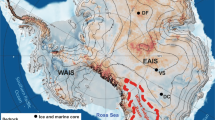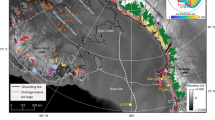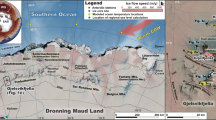Abstract
The retreat of the East Antarctic ice sheet at the end of the last glacial period has been attributed to both sea-level rise and warming of the ocean at the margin of the ice sheet, but it has been challenging to test these hypotheses. Given the lack of constraints on the timing of retreat, it has been difficult to evaluate whether the East Antarctic ice sheet contributed to meltwater pulse 1a, an abrupt sea-level rise of approximately 20 m that occurred about 14,700 years ago. Here we use terrestrial exposure ages and marine sedimentological analyses to show that ice retreat in Mac. Robertson Land, East Antarctica, initiated about 14,000 years ago, became widespread about 12,000 years ago, and was completed by about 7,000 years ago. We use two models of different complexities to assess the forcing of the retreat. Our simulations suggest that, although the initial stage of retreat may have been forced by sea-level rise, the majority of the ice loss resulted from ocean warming at the onset of the Holocene epoch. In light of our age model we conclude that the East Antarctic ice sheet is unlikely to have been the source of meltwater pulse 1a, and, on the basis of our simulations, suggest that Antarctic ice sheets made an insignificant contribution to eustatic sea-level rise at this time.
This is a preview of subscription content, access via your institution
Access options
Subscribe to this journal
Receive 12 print issues and online access
$259.00 per year
only $21.58 per issue
Buy this article
- Purchase on Springer Link
- Instant access to full article PDF
Prices may be subject to local taxes which are calculated during checkout





Similar content being viewed by others
References
Peltier, W. R. Global glacial isostasy and the surface of the ice-age Earth: The ICE-5G (VM2) model and GRACE. Annu. Rev. Earth Planet. Sci. 32, 111–149 (2004).
Fleming, K. et al. Refining the eustatic sea-level curve since the Last Glacial Maximum using far and intermediate-field sites. Earth Planet. Sci. Lett. 163, 327–342 (1998).
Clark, P. U. et al. The Last Glacial Maximum. Science 325, 710–714 (2009).
Morgan, V. et al. Relative timing of deglacial climate events in Antarctica and Greenland. Science 297, 1862–1864 (2002).
Jouzel, J. et al. A new 27 ky high resolution East Antarctic climate record. Geophys. Res. Lett. 28, 3199–3202 (2001).
Anderson, R. F. et al. Wind-driven upwelling in the southern ocean and the deglacial rise in atmospheric CO2 . Science 323, 1443–1448 (2009).
Barrows, T., Juggins, S., De Deckker, P., Calvo, E. & Pelejero, C. Long-term sea surface temperature and climate change in the Australian–New Zealand region. Paleoceanography 22, PA2215 (2007).
Rignot, E. & Jacobs, S. S. Rapid bottom melting widespread near Antarctic ice sheet grounding lines. Science 296, 2020–2023 (2002).
Mercer, J. West Antarctic ice sheet and CO2 greenhouse effect: A threat of disaster. Nature 271, 321–325 (1978).
Pollard, D. & DeConto, R. M. Modelling West Antarctic ice sheet growth and collapse through the past five million years. Nature 458, 329–332 (2009).
Alley, R. B., Anandakrishnan, S., Dupont, T. K., Parizek, B. R. & Pollard, D. Effect of sedimentation on ice-sheet grounding-line stability. Science 315, 1838–1841 (2007).
Heroy, D. C. & Anderson, J. B. Radiocarbon constraints on Antarctic Peninsula ice sheet retreat following the Last Glacial Maximum (LGM). Quat. Sci. Rev. 26, 3286–3297 (2007).
Denton, G. H., Hughes, T. J. & Karlén, W. Global ice-sheet system interlocked by sea level. Quat. Res. 26, 3–26 (1986).
Huybrechts, P. Sea-level changes at the LGM from ice-dynamic reconstructions of the Greenland and Antarctic ice sheets during the glacial cycles. Quat. Sci. Rev. 21, 203–231 (2002).
Fairbanks, R. G. A 17,000-year glacio-eustatic sea level record: Influence of glacial melting rates on the Younger Dryas event and deep-ocean circulation. Nature 342, 637–642 (1989).
Clark, P. U., Mitrovica, J. X., Milne, G. A. & Tamisiea, M. E. Sea-level fingerprinting as a direct test for the source of global Meltwater Pulse IA. Science 295, 2438–2441 (2002).
Leventer, A. et al. Marine sediment record from the East Antarctic margin reveals dynamics of ice sheet recession. GSA Today 16, 4–10 (2006).
Mackintosh, A. et al. Exposure ages from mountain dipsticks in Mac. Robertson Land, East Antarctica, indicate little change in ice-sheet thickness since the Last Glacial Maximum. Geology 35, 551–554 (2007).
Balco, G. et al. Regional beryllium-10 production rate calibration for late-glacial northeastern North America. Quat. Geochronol. 4, 93–107 (2009).
Putnam, A. E. et al. In situ cosmogenic 10Be production-rate calibration from the Southern Alps, New Zealand. Quat. Geochronol. 5, 392–409 (2010).
Domack, E. et al. Subglacial morphology and glacial evolution of the Palmer deep outlet system, Antarctic Peninsula. Geomorphology 75, 125–142 (2006).
Eittreim, S. L., Cooper, A. K. & Wannesson, J. Seismic stratigraphic evidence of ice-sheet advances on the Wilkes Land margin of Antarctica. Sedim. Geol. 96, 131–156 (1995).
Siegert, M. J. et al. Recent advances in understanding Antarctic climate evolution. Antarct. Sci. 20, 313–325 (2008).
Stone, J. O. et al. Holocene deglaciation of Marie Byrd Land, West Antarctica. Science 299, 99–102 (2003).
Conway, H., Hall, B. L., Denton, G. H., Gades, A. M. & Waddington, E. D. Past and future grounding-line retreat of the West Antarctic ice sheet. Science 286, 280–283 (1999).
Verleyen, E., Hodgson, D. A., Milne, G. A., Sabbe, K. & Vyverman, W. Relative sea-level history from the Lambert Glacier region, East Antarctica, and its relation to deglaciation and Holocene glacier readvance. Quat. Res. 63, 45–52 (2005).
Goodwin, I. D. Holocene deglaciation, sea-level change, and the emergence of the Windmill Islands, Budd Coast, Antarctica. Quat. Res. 40, 70–80 (1993).
Zwartz, D., Bird, M., Stone, J. & Lambeck, K. Holocene sea-level change and ice-sheet history in the Vestfold Hills, East Antarctica. Earth Planet. Sci. Lett. 155, 131–145 (1998).
Hodgson, D. A. et al. Were the Larsemann Hills ice-free through the Last Glacial Maximum? Antarct. Sci. 13, 440–454 (2001).
Gore, D. B. et al. Bunger Hills, East Antarctica: Ice free at the Last Glacial Maximum. Geology 29, 1103–1106 (2001).
Denton, G. H., Bockheim, J. G., Wilson, S. C. & Stuiver, M. Late Wisconsin and Early Holocene glacial history, Inner Ross Embayment, Antarctica. Quat. Res. 31, 151–182 (1989).
Hall, B. L. & Denton, G. H. Radiocarbon chronology of Ross Sea Drift, Eastern Taylor Valley, Antarctica: Evidence for a grounded ice sheet in the Ross Sea at the Last Glacial Maximum. Geogr. Ann. A 82, 305–336 (2000).
Bentley, M. J. et al. Deglacial history of the West Antarctic Ice Sheet in the Weddell Sea embayment: Constraints on past ice volume change. Geology 38, 411–414 (2009).
Johnson, J. S., Bentley, M. J. & Gohl, K. First exposure ages from the Amundsen Sea Embayment, West Antarctica: The Late Quaternary context for recent thinning of Pine Island, Smith, and Pope Glaciers. Geology 36, 223–226 (2008).
Todd, C., Stone, J., Conway, H., Hall, B. & Bromley, G. Late Quaternary evolution of Reedy Glacier, Antarctica. Quat. Sci. Rev. 29, 1328–1341 (2010).
McKay, R. M. et al. Retreat history of the Ross ice sheet (Shelf) since the Last Glacial Maximum from deep-basin sediment cores around Ross Island. Palaeogeogr. Palaeoclimatol. Palaeoecol. 260, 245–261 (2008).
Domack, E. et al. Chronology of the Palmer Deep site, Antarctic Peninsula: A Holocene palaeoenvironmental reference for the circum-Antarctic. Holocene 11, 1–9 (2001).
Brachfeld, S. et al. Holocene history of the Larsen-A Ice Shelf constrained by geomagnetic paleointensity dating. Geology 31, 749–752 (2003).
Domack, E. et al. Stability of the Larsen B ice shelf on the Antarctic Peninsula during the Holocene epoch. Nature 436, 681–685 (2005).
Denton, G. H. & Hughes, T. J. Reconstructing the Antarctic ice sheet at the Last Glacial Maximum. Quat. Sci. Rev. 21, 193–202 (2002).
Lilly, K., Fink, D., Fabel, D. & Lambeck, K. Pleistocene dynamics of the interior East Antarctic ice sheet. Geology 38, 703–706 (2010).
Ivans, E. & James, T. Antarctic glacial isostatic adjustment: A new assessment. Antarct. Sci. 17, 541–553 (2005).
Philippon, G. et al. Evolution of the Antarctic ice sheet throughout the last deglaciation: A study with a new coupled climate–north and south hemisphere ice sheet model. Earth Planet. Sci. Lett. 248, 750–758 (2006).
Lythe, M. B. & Vaughan, D. G. BEDMAP—Bed Topography of the Antarctic (British Antarctic Surv., 2000).
Imbrie, J. D. & McIntyre, A. SPECMAP Time Scale Developed by Imbrie et al., 1984 Based on Normalized Planktonic Records (Normalized O-18 vs Time, Specmap.017) (PANGAEA, 2006).
Berger, A. & Loutre, M. F. Insolation values for the climate of the last 10 million years. Quat. Sci. Rev. 10, 297–317 (1991).
Lisiecki, L. E. & Raymo, M. E. A Pliocene–Pleistocene stack of 57 globally distributed benthic δ18O records. Paleoceanography 20, PA1003 (2005).
Bard, E., Hamelin, B. & Delanghe-Sabatier, D. Deglacial Meltwater Pulse 1B and Younger Dryas sea levels revisited with boreholes at Tahiti. Science 327, 1235–1237 (2010).
Acknowledgements
The New Zealand team acknowledges financial support from VUW Foundation grants ARCCIM, ARCMORG and New Zealand FRST ANDRILL and ANZICE grants CO5X1001 and VICX0704. The US team thanks the scientific staff, Captain J. Borkowski and his ECO crew, and the Raytheon Polar Services staff who participated on cruise NBP0101. The marine work was supported by National Science Foundation grants OPP-9909367 to A.L., OPP-9909837 to R.D. and NSF-OPP grant 0732467 to E.D. The Australian team thanks the Australian Antarctic Division (AAS1071, 1332), Australian Institute of Nuclear Science and Engineering (03/048), Australian Research Council (DP0556728) and Macquarie University for logistic and financial support. We also thank staff at the Antarctic Marine Geology Research Facility at Florida State University, and T. Fanning, J. Pickard and T. Labrum for field assistance. K. Fleming provided modelled eustatic sea-level data. R. Peltier and R. Drummond provided both eustatic and relative sea-level data for the Mac. Robertson Land coast. B. Hall calibrated and interpreted 14C ages from Taylor Valley.
Author information
Authors and Affiliations
Contributions
A.M. contributed to all aspects of the work, wrote the manuscript and led the field project in Framnes Mountains. N.G. carried out the balance profile experiment, interpretation of swath bathymetry, drafted Figs 1–4 and contributed to writing. E.D. developed the idea with A.M., contributed to interpretation, writing and discussion of Antarctic-wide marine chronologies. R.D. carried out the marine radiocarbon dating/age modelling and contributed to the discussion of Antarctic-wide chronologies as well as to writing. A.L. led the NBP0101 cruise to Iceberg Alley and Nielsen Basin, helped draft Fig. 2, and contributed to the writing. D.W. carried out exposure dating chemistry, terrestrial radiocarbon dating and contributed to methodology. D.P. and R.D.C. provided ice-sheet model results and contributed to discussions concerning model interpretation. D.F. facilitated and modelled cosmogenic exposure age data and commented on the manuscript. D.Z. calculated modelled ice volume changes, drafted Fig. 5 and commented on the manuscript. D.G. led the AAS, AINSE and ARC projects, and commented on the manuscript. C.L. processed and interpreted swath bathymetry and contributed to the methodology.
Corresponding author
Ethics declarations
Competing interests
The authors declare no competing financial interests.
Supplementary information
Supplementary Information
Supplementary Information (PDF 550 kb)
Rights and permissions
About this article
Cite this article
Mackintosh, A., Golledge, N., Domack, E. et al. Retreat of the East Antarctic ice sheet during the last glacial termination. Nature Geosci 4, 195–202 (2011). https://doi.org/10.1038/ngeo1061
Received:
Accepted:
Published:
Issue Date:
DOI: https://doi.org/10.1038/ngeo1061
This article is cited by
-
East Antarctica ice sheet in Schirmacher Oasis, Central Dronning Maud Land, during the past 158 ka
Proceedings of the Indian National Science Academy (2023)
-
Central Mediterranean rainfall varied with high northern latitude temperatures during the last deglaciation
Communications Earth & Environment (2022)
-
Stability of the Antarctic Ice Sheet during the pre-industrial Holocene
Nature Reviews Earth & Environment (2022)
-
Rapid retreat of Thwaites Glacier in the pre-satellite era
Nature Geoscience (2022)
-
Response of the East Antarctic Ice Sheet to past and future climate change
Nature (2022)



